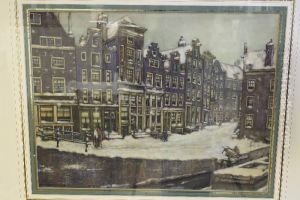Cornelis Brandenburg Paintings
Cornelis Brandenburg was a Dutch artist known for his detailed etchings of cityscapes, particularly those of Amsterdam. Born on August 18, 1884, in Wormerveer, Netherlands, he developed an interest in art at an early age. His works were influenced by the Dutch tradition of finely detailed cityscape art, which has a long history dating back to the 17th century.
Brandenburg moved to Amsterdam, where he received his formal art education at the Rijksacademie van beeldende kunsten (State Academy of Fine Arts). There, he honed his skills in drawing and printmaking. He became particularly adept at etching, a technique that involves incising a design onto a metal plate with a sharp tool called a burin, and then using that plate to create prints on paper.
Throughout his career, Brandenburg focused on capturing the architectural beauty of Amsterdam, as well as other Dutch cities. He was known for his meticulous attention to detail and his ability to evoke the atmosphere of the places he depicted. His etchings often feature historic buildings, canals, bridges, and street scenes, rendered with a high degree of realism. The play of light and shadow in his works adds to the depth and texture, making his etchings not just architectural records but also expressions of the mood of the city.
During his lifetime, Brandenburg's work was appreciated for its artistic merit and technical proficiency. He exhibited widely in the Netherlands and his etchings were collected by those who valued the traditional cityscape genre. However, he did not gain the same level of international fame as some of his contemporaries.
Cornelis Brandenburg passed away on February 23, 1954, in Amsterdam. Despite not being widely known outside of his home country, his works remain a valuable testament to the Dutch urban landscape of his time. Today, his etchings can be found in various art collections, both public and private, and continue to be admired for their beauty and historical significance.
